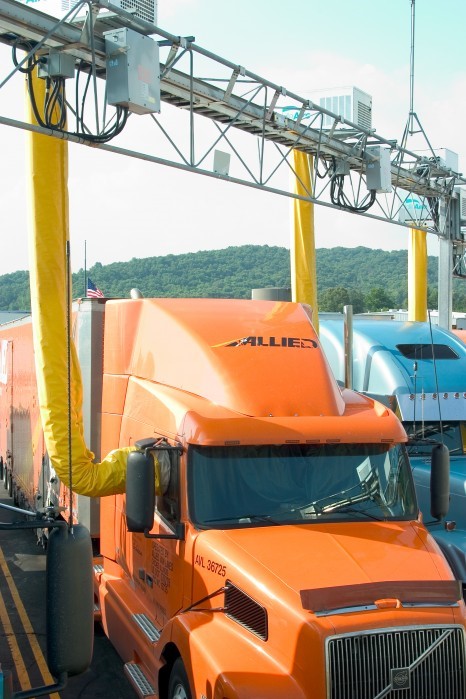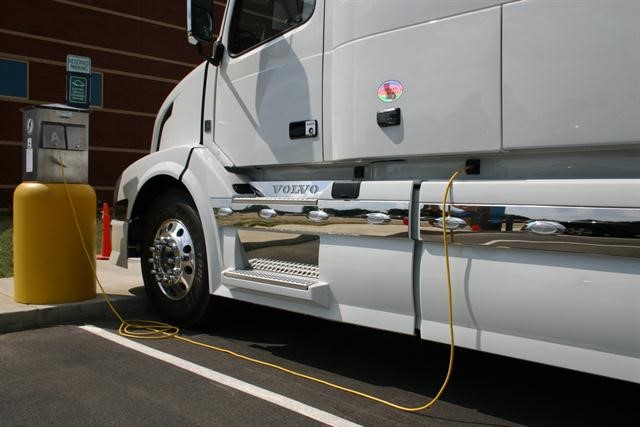National Coalition on Truck Parking: Funding, Finance, and Regulations Working Group - Emissions Reduction Grant Programs Fact Sheet
Printable Version [PDF 247KB]
You may need the Adobe® Reader® to view the PDFs on this page.
Contact Information: Freight Feedback at FreightFeedback@dot.gov

U.S. Department of Transportation
Federal Highway Administration
Office of Operations
1200 New Jersey Avenue, SE
Washington, DC 20590

What is the CMAQ Program?
The Congestion Mitigation and Air Quality (CMAQ) program provides a flexible funding source for State and local governments to fund transportation projects and programs that reduce mobile source emissions to help meet the requirements of the Clean Air Act. Funding is available to reduce congestion and improve air quality in areas that do not meet the National Ambient Air Quality Standards for ozone, carbon monoxide, or particulate matter ("nonattainment areas") and for former nonattainment areas that are now in compliance ("maintenance areas") (See 23 U.S.C. 149 and 42 U.S.C. 7407).
Since its inception in 1992, the CMAQ program has provided more than $30 billion to fund over 30,000 transportation-related emission reduction projects for State departments of transportation (DOTs), metropolitan planning organizations (MPOs), and other sponsors across the country.
Projects funded must be included in the MPO's current transportation plan and transportation improvement program (TIP) or the current State transportation improvement program (STIP) in areas without an MPO.
What is the DERA Program?
The Diesel Emissions Reduction Act (DERA) program makes funds available for diesel emissions reduction, including rebuilding diesel-powered vehicle engines to more stringent emission standards or installing emission reduction systems (See 42 U.S.C 16132). Seventy percent of the DERA appropriation is used for national competitive grants and rebates that use certified diesel emission reduction technologies. Thirty percent of the appropriation is allocated to States to fund programs for clean diesel projects. Base funding is distributed to States and territories using a formula based on overall participation. Additional incentive funding is available to States and territories that provide matching funds.
Since the program was funded in 2008 through 2013, DERA awarded $520 million. Congress authorized up to $100 million in awards annually for FY2012 through FY2016, and the Environmental Protection Agency (EPA) is awarding up to $40 million in grant funding in 2018.
CMAQ and DERA-eligible Truck Idle Reduction
- Verified Onboard Idle Reduction Technologies
- Truck Stop Electrification (TSE) and Electrified Parking Spaces (EPS)
Idle Reduction Technology (IRT)
The term "idle reduction technology" refers to devices that allow engine operators to refrain from long-duration idling of the main propulsion engine by using an alternative source of power.
An IRT device reduces unnecessary main engine idling of the vehicle or equipment and is generally one of the following:
- Is installed on a vehicle (e.g., truck, bus, truck, locomotive, automobile, etc.) or at a location where vehicles park, or
- Provides services (e.g., heat, air conditioning, and/or electricity) to the vehicle or equipment (e.g., transport refrigeration unit) that would otherwise require the operation of the main engine.

Figure 1: Image of IdleAir (courtesy of IdleAir.com)
Onboard IRTS for Trucks
Verified onboard idle reduction technologies are systems installed on the vehicle to reduce unnecessary main engine idling and include:
- Auxiliary Power Unit and Generator Set (APU/GS): An APU/GS device contains an EPA emission-certified engine that supplies cooling, heating, and electrical power.
- Fuel Operated Heater (FOH): A FOH is a small, lightweight heater that burns fuel from the main engine fuel supply or a separate fuel reserve.
- Battery Air Conditioning System (BAC): A BAC system uses batteries to power an independent electric cooling and/or heating system. Typically, a BAC system integrates a FOH to supply heating.
- Thermal Storage System (TSS): A TSS collects heat energy as a truck is driven, and uses it to provide air conditioning.
If CMAQ funding is used for an on-board IRT (i.e. auxiliary power units, direct fired heaters, etc.) the vehicle must travel within, or in proximity to and primarily benefiting, a nonattainment or maintenance area.
Truck Stop Electrification and Electrified Parking Spaces
Truck Stop Electrification (TSE) and Electrified Parking Spaces (EPS) refers to a technology that uses electricity-powered components to provide the operator with climate control and auxiliary power without having to idle the main engine. This can be on-board equipment (e.g., power inverters, plugs), off-board equipment (e.g., electrified parking spaces or systems that directly provide heating, cooling or other needs), or a combination of the two.
The EPS system provides off-board electrical power to operate the following:
- Independent heating, cooling, and electrical power system.
- Truck-integrated heating and cooling system.
- Plug-in refrigeration system that would otherwise be powered by an engine.

Figure 2: Image of ShorePower (courtesy of truckinginfo.com)
For a list of EPA-approved IRTs, please visit https://www.epa.gov/verified-diesel-tech/idling-reduction-technologies-irts-trucks-and-school-buses.
For more information about the pros and cons of IRT, please view the report titled Idling Reduction for Long-Haul Trucks: An Economic Comparison of On-Board and Wayside Technologies at http://www.ipd.anl.gov/anlpubs/2016/10/130502.pdf.
The CMAQ funding for TSE is limited to capital costs (i.e. deployment of TSE infrastructure). Operating assistance for TSE should not be funded under the CMAQ program since TSE projects generate their own revenue stream and therefore should be able to cover all operating expenses from the accumulated revenue. Commercial TSE cannot be located within rest areas of the Interstate right-of-way (ROW) (See 23 U.S.C. 111 and CMAQ Interim Program Guidance at https://www.fhwa.dot.gov/environment/air_quality/cmaq/policy_and_guidance/2013_guidance/index.cfm#ftnref47).
Examples of Successful Truck Stop Electrification Projects
| Program | Year | State | Recipient | Description |
|---|---|---|---|---|
| DERA | 2017 | MO | Metropolitan Energy Center | Replace 21 diesel long haul and work trucks with compressed natural gas (CNG) trucks; Install 41 electrified parking spaces at two locations |
| DERA | 2016 | OR | Columbia Corridor Association | Replace 10 diesel trucks; Electrify 43 parking spaces. |
| DERA | 2015 | VA | James Madison University | Replace one diesel truck with a CNG truck; Install electrified parking spaces for 143 reefer trucks. |
| DERA | 2013 | TN | Eastern Tennessee Clean Fuels Commission | Installed 20 IdleAir spaces at Covenant Transport Services in Chattanooga TN |
| Ohio Diesel Emissions Reduction | 2012 | OH | Ohio Clean Fuels | Installed 120 IdleAir spaces at four truck stops (Seville Pilot, Hubbard Flying J, Lebanon Flying J, and Beaverdam Flying J) |
| CMAQ | 2011 | GA | Atlanta Regional Commission | Installed electrification technology as an alternative to idling of diesel-powered vehicles |
| CMAQ | 2010 | GA | Ashtabula County IR90 Truck Stop Electrification | Rest Area Truck Stop Electrification project to install wind generator and truck stop electrification anti-idle infrastructure |
For more information on the CMAQ program and a list of eligible activities under this program, please visit the FHWA CMAQ website at https://www.fhwa.dot.gov/environment/air_quality/cmaq/ or the Environmental Protection Agency (EPA) CMAQ website at https://www.epa.gov/cmaq.
For more information on DERA, please visit https://www.epa.gov/cleandiesel/clean-diesel-national-grants and https://www.epa.gov/cleandiesel/clean-diesel-state-allocations and https://www.epa.gov/cleandiesel/clean-diesel-national-grants-awarded.
The examples in this report show innovative solutions for truck parking applied in a range of situations. Suitability in other locations will depend on applicable Federal laws, State standards, and site-specific considerations. This document is disseminated under the sponsorship of the U.S. Department of Transportation in the interest of information exchange. The U.S. Government assumes no liability for the use of the information contained in this document. This report does not constitute a standard, specification, or regulation. It does not create any requirements other than those stipulated in statute or regulation. The U.S. Government does not endorse products or manufacturers. Trademarks or manufacturers' names appear in this report only because they are considered essential to the objective of the document. They are included for informational purposes only and are not intended to reflect a preference, approval, or endorsement of any one product or entity.